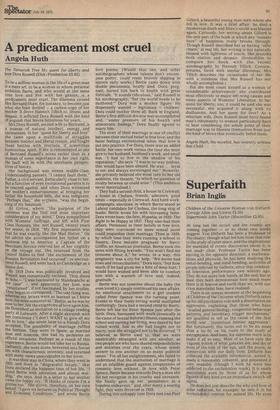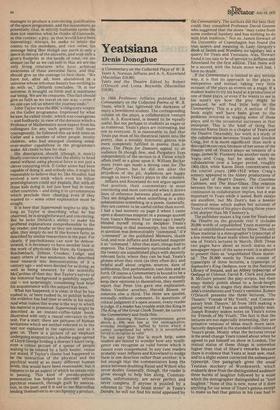Superfaith
Brian Inglis
Children of the Universe Hoimar von Ditfurth (George Allen and Unwin £5.50) Superminds John Taylor (Macmillan £3.95) At long last the occult and the cosmic are coming together — or so these two books suggest. Von Ditfurth has been a Professor of Psychiatry: though what led him from that role to the study of outer space, and the implications for mankind of recent discoveries about it, is not mada clear. Professor Taylor has been moving in the opposite direction: a mathematician and physicist, he has been studying the metal-bending, and mind-bending, activities of people infected by Gelleria, since that celebrated television performance two winters ago. They do not quite link hands, at the end; but at least they both demonstrate how much more there is in heaven and earth than we, with our crass materialist bias, have realised.
There is an uneasy moment at the beginning of Children of the Universe when Ditfurth takes up his old psychiatric role with a dissertation on aggression, explaining that those who have "sttidied general biology, congenital behaviour patterns, and hereditary trigger mechanisms" are qualified to tell us the cause of the first world war: -instinctual human aggression". But fortunately this turns out to be no more than a lay-by on his route to the study of astrophysics. And here, his supreme merit is to make it all so easy. Most of us have only the vaguest notion of what galaxies are, and do; or even of the role of the sun, and the moon, in connection with our daily lives. Ditfurth has collected the available information, sorted it, made it reasonably coherent, and presented it very readably (though I wish he were less addicted to the exclamation mark). It is easily assimilable even by those of us for whom figures of any kind are an immediate switch-off signal.
He does not just describe the why and how of solar radiation, for example: he sets it in his evolutionary context for animal life. He even
manages to produce a convincing justification of the space programme, and the moonshots, as potentially vital, in strictly humanist terms (he does not mention what he thinks of Concorde, in this context; a pity, as that would have been interesting). Always, he seeks to relate the cosmic to the mundane, and vice versa; his message being that though our earth is only a speck in the eye of the universe, and man only a gnat's footprint in the sands of time, we are unique (so far as we can tell) in that we are the only living creatures who have achieved awareness of these awesome facts; and that should give us the courage to face them. "We have not, after all, been abandoned in a universe whose inhuman beauty has nothing to do with us," Ditfurth concludes. -It is our universe. It brought us forth and it maintains our being. We are its creatures. This fact should give us faith as we travel on our way — even if no one can tell us where the journey ends."
John Taylor was the BBC's obligatory sceptic on the Geller programme. Impressed by. what he saw, he called 'credo', which was courageous — and foolhardy, in view of the derision which a Professor of Mathematics must expect from his colleagues for any such gesture. Still more courageously, he followed this up with tests on Geller and a number of other people, mostly children, who had emerged claiming mindover-matter capabilities in the programme's wake. All credit to him for that.
His description should (though it won't) finally convince sceptics that the ability to bend metal without using physical force is not just a clever conjuring trick. If Geller alone had been capable of doing it, and nobody else, it might be reasonable to believe that he, like Houdini, had evolved a new trick which even his fellow prestidigitators could not explain. But with all these kids doing it, not just here but in many other countries — and doing it in circumstances which preclude their cheating even if they wanted to — some other explanation must be sought.
It is here that Superminds begins to slip. So long as Taylor is describing what he has observed, he is straightforward and convincing. But he lacks Ditfurth's ability to make his proffered explanations comprehensible to the lay reader; and insofar as they are comprehensible, they simply do not fit the known facts, as described by similar researchers in the past. For clearly, if psychokinesis can now be demonstrated, it is necessary to have another look at the work of physicists like Hare, da Gasparin, Reichenbach, Zoliner, Crookes, Lodge, and many others of less eminence, who described their research into demonstrations of it a century ago — and were derided for so' doing, as well as being smeared, by the scientific McCarthies of their day. But Taylor's survey of the historical background is painfully superficial — not surprisingly, considering how brief his acquaintance with the subject has been.
What has happened, it is clear, is that he has rushed in, or been rushed in, to publish before the evidence has had time to settle in his mind. And what makes this worse is the way in which his material is presented. Superminds might be described as an instant-coffee-table book, illustrated with only a casual relevance to the text. For a start, there are pictures of human levitations which are neither referred to in the text nor explained in the captions; and so it goes on. There is a picture of an elephant undergoing acupuncture; a double-page-spread of Lloyd George holding a dowser's hazel twig; even a colour picture of a queue of people waiting to be treated by a faith healer, venue not stated. If Taylor's theme had happened to be the interaction of the physical and the psychical world at so many different human levels, this would have been reasonable; but it happens to be an aspect of which he treats only in passing. This kind of pseudo-popular presentation has helped to discredit serious psychical research, through guilt by association, in the past; and it is sad to see Macmillan lending themselves to so catchpennya product.



































 Previous page
Previous page